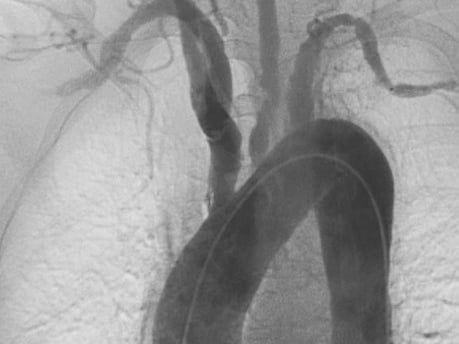Aortic Arch Syndrome: Causes, Symptoms, Diagnosis, and Treatment
Aortic Arch Syndrome is a group of disorders that affect the arteries branching from the aortic arch, leading to reduced blood flow to the head, neck, and arms. These conditions can result from inflammation, atherosclerosis, or congenital defects. One of the most well-known causes is Takayasu's arteritis, a rare inflammatory disease affecting large arteries. Early diagnosis and proper management are crucial to prevent severe complications such as stroke or organ damage.
CARDIOLOGY
Rishwin A R
2/8/20252 min read


Causes
Aortic Arch Syndrome can arise from multiple underlying conditions, including:
1. Takayasu's Arteritis
A rare autoimmune vasculitis that causes inflammation of large arteries, leading to narrowing and reduced blood supply.
More common in young women, particularly in Asian populations.
2. Atherosclerosis
A buildup of fatty deposits (plaques) in the arterial walls, leading to narrowing and blockages.
More common in older adults and those with risk factors such as high cholesterol, smoking, and hypertension.
3. Congenital Malformations
Some individuals are born with abnormalities in the aortic arch, leading to circulation issues.
Conditions such as coarctation of the aorta can result in significant blood flow restrictions.
4. Other Causes
Syphilitic arteritis (a rare complication of syphilis affecting the arteries).
Trauma or injury to the aortic arch region.
Giant cell arteritis, another inflammatory disorder affecting large arteries.
Symptoms
The symptoms of Aortic Arch Syndrome vary depending on the underlying cause and severity of arterial involvement. Common signs include:
Dizziness and fainting (due to reduced blood flow to the brain)
Weakness or pain in the arms (especially with use, due to inadequate blood supply)
Differences in blood pressure between the arms
Blurred vision or vision loss (due to reduced blood supply to the eyes)
Headaches and neck pain
Difficulty swallowing (dysphagia) in severe cases involving the esophagus
Stroke or mini-stroke (transient ischemic attack, TIA)
Diagnosis
A thorough evaluation is necessary to confirm Aortic Arch Syndrome and determine its cause. Common diagnostic methods include:
1. Physical Examination
Checking for weak or absent pulses in the arms.
Measuring blood pressure differences between limbs.
2. Imaging Tests
CT Angiography (CTA) or MRI Angiography (MRA): Provides detailed images of the aortic arch and its branches.
Doppler Ultrasound: Assesses blood flow and detects blockages in the arteries.
Conventional Angiography: Uses contrast dye and X-rays to visualize arterial abnormalities.
3. Blood Tests
Inflammatory markers (ESR, CRP) to check for autoimmune involvement.
Lipid profile to assess atherosclerosis risk.
Treatment
Treatment depends on the underlying cause but generally includes:
1. Medications
Corticosteroids (e.g., prednisone): Used to reduce inflammation in conditions like Takayasu's arteritis.
Immunosuppressants: Methotrexate or azathioprine may be required for autoimmune conditions.
Blood pressure and cholesterol medications: Help manage atherosclerosis.
Antiplatelet drugs (aspirin, clopidogrel): Reduce the risk of stroke and blood clots.
2. Surgical and Interventional Procedures
Angioplasty and stenting: Opens narrowed arteries to restore blood flow.
Bypass surgery: Redirects blood flow around blocked arteries.
Endarterectomy: Removes plaque buildup from arteries in cases of severe atherosclerosis.
3. Lifestyle Modifications
Regular exercise and a heart-healthy diet to improve vascular health.
Smoking cessation to prevent further arterial damage.
Managing underlying conditions such as diabetes and hypertension.
Conclusion
Aortic Arch Syndrome is a serious but manageable condition when diagnosed early. Whether caused by inflammation, plaque buildup, or congenital defects, timely intervention can prevent life-threatening complications like stroke. If you experience symptoms such as arm weakness, dizziness, or vision disturbances, seeking medical advice promptly can make all the difference.
Frequently Asked Questions (FAQs)
1. Is Aortic Arch Syndrome life-threatening?
It can be if left untreated, as it may lead to stroke or organ damage. However, early diagnosis and treatment significantly improve outcomes.
2. Can Aortic Arch Syndrome be cured?
While some causes, like inflammation, can be controlled with medication, others (such as congenital defects) may require surgical intervention.
3. Who is most at risk for Aortic Arch Syndrome?
Individuals with autoimmune diseases, atherosclerosis, or congenital heart defects are at higher risk.
4. What is the difference between Takayasu’s Arteritis and Aortic Arch Syndrome?
Takayasu’s Arteritis is a specific inflammatory condition that can cause Aortic Arch Syndrome, but the syndrome itself can have other causes as well.
5. How can I prevent Aortic Arch Syndrome?
Managing risk factors like high cholesterol, hypertension, and smoking, along with regular health check-ups, can help prevent some forms of the syndrome.
Syndromes.xyz
Explore medical syndromes and their details here.
For Educational purposes only
The information on this site is not in any way, replacement for professional advice. Always consult your physician regarding personal queries
Connect
Support
syndromesxyz@gmail.com
© 2024. All rights reserved.
